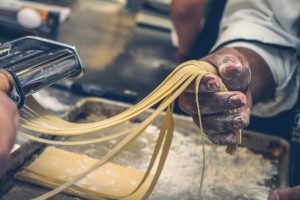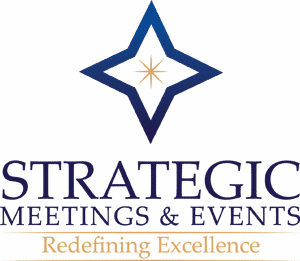Recognizing the Awesome Power of the Plate
By Kirsten Rockwood
Recognizing the awesome power of the plate, savvy planners carefully select every attendee’s bite with the skill and precision of a seasoned chef—knowing that the tastes and feelings associated with each meal will linger long after the event.
The education is top-notch, the pool sparkling and the golf course award-winning, but odds are if the food is forgettable, the meeting will be, too.
“Food is what lingers,” said Erin Tench, CMP, director of events and communications for The Hyland Group and a member of the MPI Potomac Chapter. “With so many different meetings to attend and budgets being trimmed, people will choose to come back to the events with the best food and beverage.”
 A meal’s staying power is increasing thanks to a society increasingly consumed by food, fueled by the rise in popularity of TV cooking shows, culinary magazines, and the Internet. Twenty years ago, Americans were just waking up to a culinary heritage of their own power, learning to rely on native recipes and ingredients to create beautiful dishes, says Tonya Wenman Steel, editor in chief of Epicurious.com. Now, she sees an increasing level of sophistication and power in the American palate.
A meal’s staying power is increasing thanks to a society increasingly consumed by food, fueled by the rise in popularity of TV cooking shows, culinary magazines, and the Internet. Twenty years ago, Americans were just waking up to a culinary heritage of their own power, learning to rely on native recipes and ingredients to create beautiful dishes, says Tonya Wenman Steel, editor in chief of Epicurious.com. Now, she sees an increasing level of sophistication and power in the American palate.
And meeting planners agree. According to a recent MPI survey of 300 planners, 70 percent said they have more-refined expectations of meals at meetings.
Tony Conway, CMP, president of A Legendary Event in Atlanta and a member of the MPI Georgia Chapter, attests to his clients’ desires for restaurant-quality experiences in a meeting setting. Attendees have become food and wine savvy, he says, and will appreciate—and expect—finer dining experiences.
This wave of change is reverberating throughout the meetings industry with an increased emphasis on chefs, cooking, and venues. Organizations such as the International Association of Conference Centers (IACC) are recognizing superstar chefs with events such as its annual Copper Skillet Award/International Chef’s Competition. Inaugurated in 2004, the coveted recognition proves that conference dining is transforming into a valuable selling point.
Each meal represents a venue’s opportunity to please, and when a convention center or hotel doesn’t present its best, planners with the power are much less inclined to book it for the next year.
Last year, Bonnie Wallsh, CMP, of Charlotte, N.C.-based Bonnie Wallsh Associates, hosted a three-day event for several hundred clients who were served from the same menu throughout the conference. The food quality was standard, she says, but attendees were so bored with the food by the last day that everyone was unhappy and complaining.
The right food can make—or break—a meeting. Recognizing the awesome power of the plate, planners can employ a variety of tactics, including interactive dining and creative breaks, to bolster learning and engender fond meeting memories.
“The facility and staff were wonderful, but the reason we will not use that conference center again was the food,” said Wallsh, a member of the MPI Carolinas Chapter.
Beyond taste, the value of food and beverage (F&B) to meeting planners can be intense, as what an attendee consumes translates to his or her attitude, performance, and mood for the rest of the day.
“A well-fed, happy attendee will continue to pay attention,” said Christy Lamagna, CMP, CMM, president of Strategic Meetings & Events in Bernardsville, N.J. Venues around the globe are promoting F&B offerings that go beyond traditional meeting fare. Elements such as creative breaks, menu samplings and the accessibility, flexibility, and ingenuity of the chef allow planners to provide attendees with memorable meeting experiences. And as more and more venues focus on cuisine, planners can afford to be discerning when choosing the perfect spots for their next events.
Meet What You Eat
Food has become an experience, an opportunity for attendees to have fun and enjoy themselves. Meals are highly anticipated punctuations in days crammed full of meetings, and planners should position them as pleasurable experiences instead of a distribution of the day’s rations. By working with venues’ catering staffs well before meetings commence, planners will be acquainted with the food resources at their disposal and foresee any difficulties in service, dietary requirements or timing.
Lamagna visits a venue at least one month prior to an event and goes through each dish with the chef. For the higher-end meals, she experiences it exactly the way an attendee would by recreating the meal—down to the color of the table linens and the flowers in the centerpiece.
 “If the carrots clash with the tablecloth, we will rework the whole thing,” said Lamagna, a member of the MPI New Jersey Chapter. “This takes a tremendous amount of time, but it’s necessary if you’re looking for a flawless event.”
“If the carrots clash with the tablecloth, we will rework the whole thing,” said Lamagna, a member of the MPI New Jersey Chapter. “This takes a tremendous amount of time, but it’s necessary if you’re looking for a flawless event.”
And more recently, chefs are taking an active role in not only the preparation, but also the planning, distribution, and reception of the meal. They are with planners every step of the way, sharing the power, and ensuring that events’ F&B experiences are perfect.
This level of chef interaction is becoming standard as venues realize the potential their culinary stars have to woo possible clients. It’s not uncommon for planners on site visits to meet with chefs to discuss menu and break options for a group. Chefs understand the role they play in selling a venue to a planner, and they are usually eager to work the menu around a planner’s budget and dietary restrictions—all you have to do is ask.
“We love to do custom things,” said Robert Fallon, executive chef at JW Marriott Desert Ridge Resort & Spa in Phoenix. “We have a set banquet menu, but most times we throw it out. Talking with meeting planners is a big part of my job and they know their groups the best. We don’t like to do anything that’s not the best.”
Fallon attests to the success of an attendee’s interaction with food. He is joined by a legion of other venues that are dishing up meals at stations throughout the room—either preparing the course in front of the lucky diners or allowing guests to create their own meals by hand-selecting toppings or fillings.
“We are increasingly doing more [live] food preparation than ever before,” said Michael Burton, director of catering and conference services at Omni Orlando Resort at ChampionsGate in Florida. “The more interaction you add to an event, the better it flows. We always look at a course or a meal and ask, ‘Can we make this a station instead?’”
ChampionsGate routinely positions its chefs around the event to be on hand to discuss the preparation of the food with guests and the chefs have even been known to jot down a recipe in cases of persistent pleading.
Meeting with a chef can be a money-saver as well. By relying on the chef to select ingredients that are in season and can be purchased at lower prices, a planner can work to create a menu that is fabulous and below budget. Planners can also ask what other groups at the venue will be eating at the same time as their event. By “piggybacking” on other meals, kitchens can order in larger quantities, saving money on the back end.
Good for You
Although food can be fun, planners must remember that it still serves the basic function of nourishing attendees. Satisfied attendees will pay attention during the day’s lectures and seminars, and if they can count on good, nutritious meals, then they are less likely to skip out on the lunch meeting to find better food off site.
According to a recent survey by Englewood, Colo.-based Destination Hotels & Resorts, meeting food has taken a healthy turn and most planners are skipping dishes with heavy sauces and buttery sides. The results taken from more than 500 meeting planners show that 60 percent are somewhat to very likely to pay more for healthier food choices, and 92 percent indicate healthy food choices are a somewhat to very important factor when selecting a meeting venue.
Though fads such as low-carb diets are fading, planners are still relying on meals that are high in protein to power up attendees and keep them focused throughout the day.
Eggs are still essential at breakfast, but planners lighten them up by serving a vegetable frittata with fruit instead of cheesy scrambled eggs with bacon.
When planning European meetings, don’t expect the venue’s staff to always understand U.S. diets.
“In each European country, keep your eye on the menu and be careful of local food because it’s often OK for locals, but not for visitors,” said Barbara Schwaiger, CMP, sales and marketing manager for the Salzburg (Austria) Congress. “For example, in Austria we eat heavy food—dumplings and such—but in smaller portions. Everyone eats something different for breakfast. If your group is mainly American, you’ll have to tell the venue that you need lots of ice water, because we never drink it.”
Planners know that attendees, who are used to traveling, are very health-conscious and won’t want to attend a conference that will disrupt their eating habits. The challenge, however, isn’t offering low-fat food, but serving a variety of healthful dishes so that guests aren’t bored.
 “People expect something different from what they had at a previous meal and even the previous conference,” Tench said. “The trick is to sit down with convention services and the chef and create new menus to keep it creative. It is extremely important that the power of the venue is flexible.”
“People expect something different from what they had at a previous meal and even the previous conference,” Tench said. “The trick is to sit down with convention services and the chef and create new menus to keep it creative. It is extremely important that the power of the venue is flexible.”
Flexible venues are also essential for attendees with special dietary needs. Recognizing the significance of guests’ food preferences will enable them to get the most out of an event, and it is planners’ responsibility to be aware of those needs.
Quick surveys, either e-mailed or mailed, taken a month or two before the event will give planners a thorough demography of their groups. Knowing the age, gender, and hometown of an attendee will also be valuable in creating a menu adapted to everyone’s tastes.
Venues expect that specific requests will be made—now more than ever. Instead of only vegetarian and Kosher, venues are expected to accommodate vegan, gluten-free, and Halal dietary restrictions—among many others. Venues appreciate advanced notice of special dietary concerns, says Michael Tracey, executive chef at the Boston Convention & Exhibition Center. Tracey and his staff, like at many other venues, are committed to making an attendee’s dining experience problem-free, but he says the more time they have for preparation, the better a sensitive diet can be accommodated by creating new dishes.
And rather than feeding the affected attendee the tedious vegetable plate, many kitchens will go above and beyond to serve him or her something more palate-pleasing.
Robert Krause, founder of Plann-It Meetings & Events in San Diego, worked with a venue to power assemble a strictly vegetarian dish that looked exactly like the steak and mashed potatoes the other guests received. The attendee was well-fed and sincerely appreciated not being singled out.
Give Me a Break
Guests appreciate the time off from a day of lectures, and a well-planned break can provide much-needed relaxation, a power boost, or a diversion. Keep in mind what activity your attendees are heading to next or what it is they have come from. Position a yoga break with fresh fruit, granola and herbal teas after an intense training session, or offer Red Bull and energy bars before a motivational speaker.
While attendees may be clamoring for healthy fare, planners can’t forget to satiate their desires for sweets.
“I don’t care how many people are on a diet,” Wallsh said. “People love their chocolate.”
By offering smaller portions, sweets can be included without ruining attendees’ healthy regimens. Chocolate is so popular, Burton says, that he and his team created a candy-coated break that hit all attendees’ senses. He set the mood with a chocolate scent machine and had music from Willy Wonka and the Chocolate Factory playing as guests exited the meeting. Servers dressed as oompaloompas offered all types of chocolate and sugary treats.
Most importantly, breaks should be enjoyable, and the easiest way to do this is through theming. Breaks don’t need to be expensive, just cohesive. Serve barbecue-flavored potato chips with root beer, suggests Krause, or try milk and chocolate chip cookies, recommends Wallsh.
While breaks provide attendees with valuable opportunities to refresh and rejuvenate, snacks placed in attendees’ rooms at night can also make them feel special. Planners show tremendous professionalism by doing a little bit of research to find out VIPs’ favorite snacks or drinks. Don’t send an expensive bottle of wine or liquor to someone who doesn’t drink, or an elaborate tray of truffles to someone who is dieting.
Wallsh’s favorite evening gift wasn’t one that she sent out, but one that she received. She was really impressed by a tin lunch box filled with moon pies, chocolate milk and candies. Tucked inside was a handwritten note from ‘Mom,’ reminding her to get enough sleep in order to be wide awake for the next day’s events.“It’s obvious when you go above and beyond,” she said.
Drink It In
While meeting attendees are expanding their knowledge and appreciation of fine foods, they are also growing in their acquaintance with wine. Many venues work with sommeliers to select the perfect accompaniment for each meal or course, and planners love taking advantage of local vintners.
The Ontario (Calif.) Convention Center teams with native vineyards to offer wines produced in the region. Attendees from around the globe can sample California’s finest, and the partnerships formed between the vineyards and the Center will lend themselves to a better value for planners.
Planners can also limit alcohol spending by asking venue representatives about leftover cases of wine, liquor or beer from previous events. They may not have enough to advertise it on a menu, but venue staff could be willing to sell it to planners at a reduced rate.
 In terms of alcohol consumption, meetings and events can range from dry to full bar and depending on the demography of the group, planners can choose the format that is best. But planners must realize that any amount of alcohol present at an event carries with it a certain degree of risk.
In terms of alcohol consumption, meetings and events can range from dry to full bar and depending on the demography of the group, planners can choose the format that is best. But planners must realize that any amount of alcohol present at an event carries with it a certain degree of risk.
Meetings industry attorney Tyra Hilliard, CMP, associate professor at the University of Nevada-Las Vegas and a member of the MPI Potomac Chapter, says the best way to ensure the safety of guests at an event where alcohol will be consumed is to mandate that specially trained professionals serve the drinks. Both planners and venues should also have insurance covering alcohol-related risks. Planners should have a commercial general liability policy in place for any event, and they should check with their insurance agents before events to make sure claims will be covered.
When planning international events, be sure to check the country’s stance on alcohol, suggests Marie Burewall, North American director of the Swedish Travel and Tourism Council. Alcohol customs are different in all European countries, depending on tradition and taxes. For example, Sweden has placed high taxes on hard liquor, and a client’s budget would stretch much further if only beer and wine were served instead.
Schwaiger notes that alcohol is commonly served at lunch in many European countries, a custom that Americans may not be familiar or comfortable with. Planners should be aware of the local eating and drinking habits when booking international meetings.
F&B Spotlight: JW Marriott Desert Ridge Resort & Spa
The JW Marriott Desert Ridge Resort & Spa in Phoenix recently received accolades placing it at the top among all Marriott properties. Robert Fallon (left), the resort’s executive chef, was awarded and recognized as Marriott’s ACE (Award Culinary Excellence) Executive Chef of the Year for 2005. This award is based not only on dining quality, but also on guest satisfaction, team satisfaction, and community involvement.
“It’s a kind of business where you need to be passionate at all times, always staying on top of your game,” said Fallon, who combines a sincere concern for customer approval with a Culinary Institute of America education. He and his culinary team are always scouting new trends, offering the finest cuisine to groups in the most innovative ways possible. Fallon champions menus that let guests choose their own appetizers, entrées, and desserts. This system can be successful for up to 1,000 guests and is an extremely desirable option for planners with varying group demographics.
“We are trying to meet the needs of our guests on a much more personal level,” Fallon said.
JW Marriott Desert Ridge boasts 10 different dining options for guests, including Blue Sage, with a Southwestern menu crafted by celebrity chef Mark Miller, and Roy’s Restaurant, the namesake of notorious Hawaiian restaurateur Roy Yamaguchi, boasting a Hawaiian-Asian fusion menu, cozy fireplaces, and a sushi bar. Both are available for group dining.
F&B Spotlight: Caesars Palace
The iconic Caesars Palace hotel in Las Vegas claims to have prompted the luxury-dining craze in Sin City more than a decade ago with the opening of Spago. Now, Caesars Palace (with 240,000 square feet of meeting space) boasts 24 award-winning restaurants and cafes, two of which are headed by celebrity chefs Bradley Ogden and Bobby Flay (right). Meeting attendees are wooed by the possibility of savoring one of their creations not only when scoring a table at one of their acclaimed eateries, but also when dining at the convention center.
“‘No’ is not an answer for us,” said Greg Waldron, executive vice president of food and beverage for Caesars. “What a planner wants, we are able to provide, including a catered meal for 1,000 created by Bobby Flay.” For a price, planners can offer their attendees a feast created by any of the acclaimed chefs at the property. The dining experience afforded by Caesars is an epicurean’s dream, as meeting attendees have no need to even leave the property to try something new. Gourmets will appreciate the acclaimed onsite restaurants, including Mesa Grill, Bradley Ogden and Restaurant Guy Savoy, opening in 2006. Each of Caesars’ restaurants has private dining rooms suitable for groups and many are tiered or satellite-designed, lending themselves easily to meetings.
F&B Spotlight: Taboo Resort, Golf & Spa
Taboo Resort, Golf & Spa, north of Toronto in Muskoka, is in Canada’s “Hamptons” region. Visitors here are often seeking a quiet respite from the rigors of daily life, and they find it near the hushed lake, fragrant forests and in the incredible culinary experience served by Taboo’s award-winning team of chefs.
Executive Chef Alain Irvine (right) took first place at Canada’s International Association of Conference Centers (IACC) Copper Skillet competition this year. The resort itself has notched scores of impressive awards, including “Best Out-ofTowner Restaurant” by Frommer’s and “Planner’s Best Bets: Best Restaurant” by MeetingsEast magazine.
And don’t be fooled by the resort’s rustic exterior charm. Inside, contemporary design, lavish amenities, and avant-garde cuisine wow guests. Diners can feast on such delicacies as seared sea bream, roasted Nova Scotia lobster and grilled bison ribeye, and meeting-goers rave about the innovative, fresh, and often-local banquet fare.
Taboo recently completed the first of a two-part renovation project, including a complete makeover of guest rooms, public areas, and meeting rooms. The resort also used this time to add a culinary theater (left), a setup accommodating up to 60 to view resort chefs creating dishes according to viewers’ tastes. The setup can also be used for cooking classes for up to 20. This option lends itself well to board retreats and smaller groups.
F&B Spotlight: Gold Coast Convention & Exhibition Centre
Barely a year old, the Gold Coast (Australia) Convention & Exhibition Centre already boasts a power winning reputation. At the Restaurant and Catering Queensland Gold Coast Awards in July, the centre took home top honors for “Caterer of the Year” and “Function/ Convention Centre Catering.”
It’s no surprise that the venue is receiving such acclaim. Led by Chef Michael Fletcher (right), the property boasts cutting-edge facilities and eight satellite kitchens that allow food to be prepared as close to the meeting as possible.
The centre can host up to 2,200 for banquets, but it is committed to a level of service that allows everyone to eat at the same time. The kitchen staff works extremely closely with its operations department to develop food presentations that ensure quick delivery. A vegetable stack, for example, may seem like an excellent side choice that is beautifully displayed, but the team will quickly tell you that it is complicated and will slow down delivery time.
“There is nothing worse than having one guest at the back of the room receiving his main [course] when another guest at the front is having her plate cleared,” Fletcher said.
One extremely popular option for groups is ‘table grazing,’ where guests enjoy a buffet brought to their table. Without having to stand and walk around the room, they are able to pick and choose their portions, and the meal becomes an effective method of networking.
Tina’s Tidbits
Team-building exercises have the remarkable ability and power to draw a group closer within a few hours. Managers and directors depend on these activities to enhance productivity and trust within a group.
According to Dallas-based cooking instructor and team-building facilitator Tina Wasserman, “food is an equalizer.” Everyone is comfortable around food, she says, and when people are comfortable, true personalities come through, and a team’s objectives can be realized. Wasserman, who has planned events for groups such as Microsoft, Blockbuster and Citi Financial, is part of the growing trend of cooking classes as group team-building sessions. Eating is an enjoyable pastime for almost everyone, and the session can be manipulated for everything from meeting and greeting to strategic business models.
Before heating up the stove, try these tips from Tina to ensure that your next group cooking experience doesn’t boil over.
• Don’t allow the class to go longer than three to three-and-a-half hours. Attention spans don’t last much longer than this.
• Though a glass of sauvignon blanc may go perfectly with that shrimp dish, don’t allow any drinking before the class begins and limit consumption during the class to one or two drinks.
• An ideal team-building class size ranges from 10 to 20.
• Select an instructor that has both a cooking and a marketing or business background. This class has a dual purpose: learning how to bake the perfect chocolate chip cookie and integrating your team into a new business power plan.
• Work with an instructor who is engaging and fun, and who you think will get along well with your group. The class will go much more smoothly if everyone is enjoying the experience.
Tags: Recognizing The Awesome Power Of The Plate, Power Of The Plate, Awesome Power, Power, Event Planning, Event Planners, Strategic Planners, Strategic Events, Corporate Meetings, Corporate Events, Meeting Professionals International, MPI





